KENYA
A. THE COUNTRY
The Republic of Kenya, in eastern Africa, has only 8.9% of the land
cultivable with much of the north and east being desert. It has a
multiparty government, but there is corruption within the state
mechanisms. Task forces are targeting corruption in the country, but it
is so entrenched that terrorists and international drug traffickers use
Kenya as a key hub. The economy is predominantly agriculture, light
industries and a major tourist industry. Fragile ecosystems, overdue
land reform, widening gaps between rich and poor, increasingly scarce
water, rapidly expanding urban slums and burgeoning population of street
children/AIDS orphans increase tensions. Drought, floods and famines
have laid large waste areas, causing food prices to rise and devastating
the livestock populations. The severe July 2011 drought is the worst in
decades and large numbers are dying of starvation.
B. THE PEOPLE
The population is ~40,863,000 and the official languages English and
Swahili. There are 108 ethno-linguistic groups.
~66% are Bantu, ~29.8% Nilotic, ~2.7% Cushitic, ~0.1% Khoisan, ~0.3%
South Asian, ~1.1% Other.
C. RELIGIONS AND CHRISTIANITY/PENTECOSTALISM
Kenya has a massive evangelical presence at nearly 50% of the
population. Pentecostal churches in particular show growth at nearly
triple the country’s rate of population growth. Christian-Muslim
tension is at an unprecedented level and violent outbreaks are
increasingly common.
Without a survey for decades, these figures are estimates only: ~82.61%
claim to be Christian, ~8.32% Muslim, ~7.21% Ethnoreligionist, ~0.98%
Baha’i, ~0.41% Hindu, ~0.23% Non-religious, ~0.19% Other, ~0.05% Sikh.
In the Christian category:
~32.57% are Protestants, ~24.2% Independent, ~21.54% Catholic, ~8.86%
Anglican, ~0.84% Orthodox, ~0.36% are considered ‘marginal’.
Evangelicals represent ~48.9% of the population.
Charismatics represent ~39.5% and of those ~18.6% are Pentecostals.
Donna Siemens
References:
http://en.wikipedia.org
Operation World, Jason Mandryk. Colorado Springs: Biblica Publishing, 2010.

